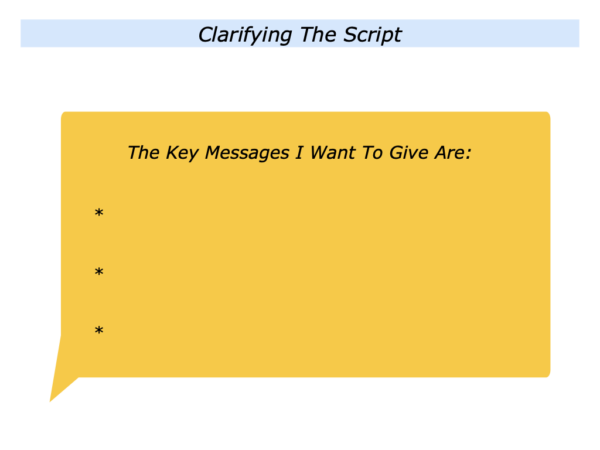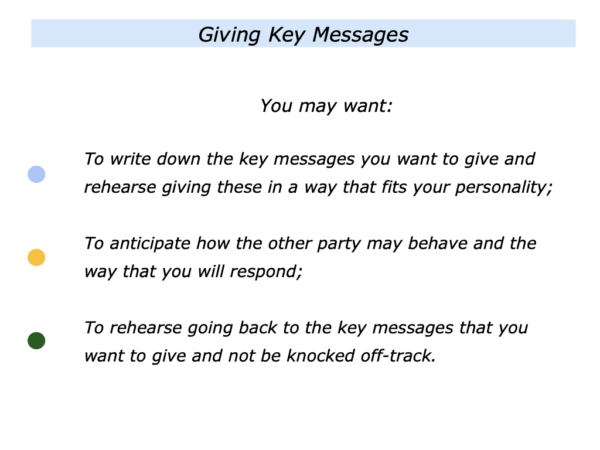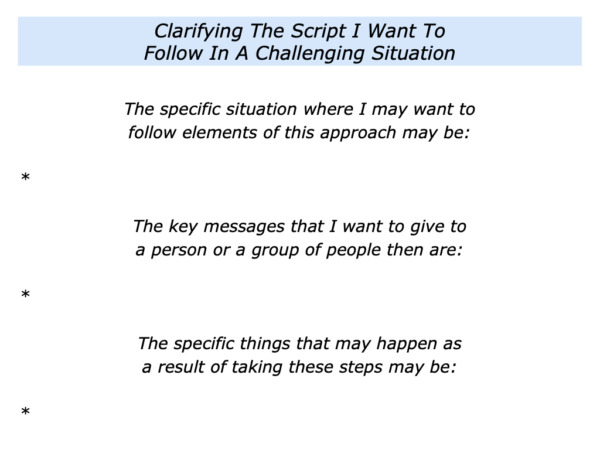
There are many ways to communicate with people. One approach is to clarify the key messages you want to give to a person or a group of people in a challenging situation.
This approach sometimes involves taking the following steps. You can aim:
To write down the key messages you want to give and rehearse giving these in a way that fits your personality;
To anticipate how the other parties may behave and the way that you will respond;
To rehearse going back to the key messages that you want to give and not be knocked off-track.
Looking back, can you think of a situation when you took this approach? You may have done this when either:
You were ending a relationship;
You wanted to give somebody clear messages about how you would prefer them to behave in the future;
You needed to give a tough message to an employee;
You wanted to explain the decision you had made about your chosen way forwards.
Let’s explore how some people have dealt with such situations. Sometimes these involved the person wanting to get things off their chest.
They then realised that the way they planned to do this could lead to difficulties. Bearing this in mind, they focused on how to give certain messages in an effective way. Here are some examples.
Saying You Are Moving
To Another Company
Dave was going to leave his present employer for a new job. He planned to break the news by telling his manager he was disappointed that the organisation had not fulfilled certain promises.
This approach could come across as negative. We therefore explored how to manage the situation in a more positive way.
Dave wanted to leave on a good note. Bearing this in mind, he formulated the script he wanted to follow.
Looking ahead to meeting his manager, he aimed to give them the following messages. He would do this in a calm and clear way.
“I have learned a lot here and it is has been a good couple of years.
“I have been offered an opportunity that plays to my strengths and I am planning to take it.
“I will do everything possible to make a good handover to whoever replaces me.”
His employer was shocked at first, but Dave gave the messages in a professional way. Saying that he wanted to move to the role that played to his strengths, he did not go over old ground. This helped him to move on in a positive way.
Giving Tough Messages
To A Team Member
Imagine that you want to give tough messages to an employee about the way they behave.
Some managers start by identifying where the team member is failing. They then aim to point these out to the person and urge them to change. Sometimes this can work, sometimes it fails.
Another approach is to explain the professional standards you want the person to follow in the future. It is to then invite them to decide if they want to behave in these ways.
Imagine you are going to have such a conversation with a person. You may want to give them the following messages.
“As you know, we have certain professional standards that people need to follow to deliver the agreed goals. These include the following things that we expect people to do:
*
*
*
“Looking ahead, I would like to decide if you want to follow these professional standards. This would involve you choosing to do the following things:
*
*
*
“I would like you to take time to reflect to decide if you want to follow these professional standards. If so, then I would also like you to let us know the specific things you want to do to translate these into action.”
You may want the person to demonstrate a positive attitude, encourage their colleagues and manage their key stakeholders. It can be useful to give examples of how they can do this in the future.
How to give these messages? There are some Dos and Don’ts you may wish to follow.
Do keep referring to the required professional standards. Do give examples of how they can translate these into action in the future. Do show the benefits to them and to others of behaving in these ways.
Do focus on the future and don’t get into arguments. Dirty fighters sometimes want to get you into the gutter and fight about details. Don’t fall for it. Do keep saying it is up to them to decide if they want to follow the required professional standards.
Looking ahead, can you think of a challenging situation where you may want to give some key messages to a person or a group of people? You may have certain feelings that you want to express, but it will be important to consider the following things.
Clarify what you can and
can’t control in a situation
You can control your attitude and how you give the messages. You can’t control the way people receive them or how they will react.
Clarify what you do and don’t
want to do in the situation
You may want to be calm, positive and professional. You may also want to achieve certain aims. You may not want to be a victim or come across as blaming others.
Clarify the key messages you
want to give in the situation
Clarify how to position the conversation. Depending on the topic you want to discuss, you may say something like:
“I would like to talk with you about something when you have the time. It is about some of the possible ways forward. Can you let me know when it may be a good time to talk?”
The way you position the conversation will depend on the topic you want to cover. If possible, position it in a way so that the other party has the chance to prepare themselves for the conversation.
Write down the key messages you want to give to the person or group of people. Looking at these messages, you may want:
To change any negative ones into giving the other person or the group of people positive suggestions or alternatives;
To, if appropriate, focus on how you or the other party can behave in a positive way in the future.
You can clarify what you want to say and also rehearse the situation. Let’s return to some of the things, it can be worth bearing in mind.

Let’s look at another situation where a person may want to clarify and give certain messages.
A medical consultant may be due to see a patient who has been through several courses of chemotherapy. The latest x-rays show that the illness is worsening.
How to break the news? The consultant will aim to show respect to the person but also explain the realities of the situation. Making the person feel welcome, they may then say something along the following lines.
“We have got the x-rays back and unfortunately it is not the news we were hoping for. There are, however, several ways forward. Each route has both pluses and minuses.
“What would you like me to do first? I can explain the x-rays or I can go through the possible ways forward. Which would you prefer?”
Sometimes it is hard to give tough news but people want to be treated like adults. They also want the opportunity to explore the ways forward and then make decisions.
Let’s return to your own life. Looking ahead, can you think of a challenging situation where you may want to give certain messages to a person or a group of people?
What may be the specific situation? What may be the key messages you want to give to a person or a group of people? How can you give these in your own way? What may happen as a result of taking these steps?
If you wish, try tackling the exercise on this theme. This invites you to complete the following sentences.







Leave a Reply